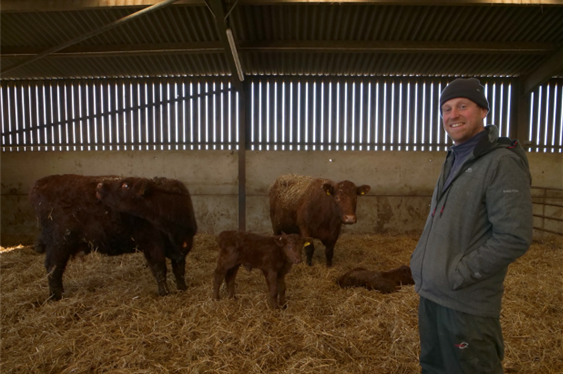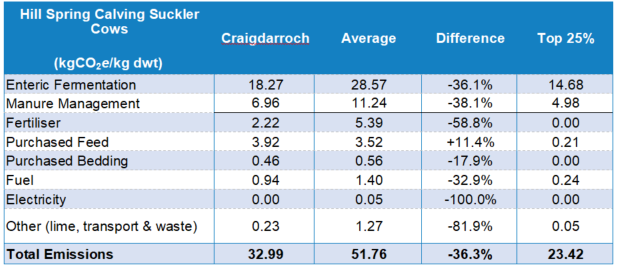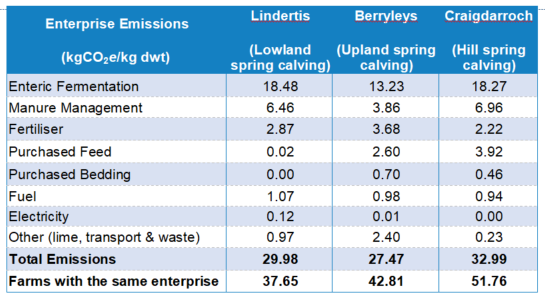Calving Heifers at 3 Case Study
3 April 2023Billy Graham, Craigdarroch Farm
The Graham family have farmed at Craigdarroch Farm on the outskirts of Sanquhar since 2000. Craigdarroch is a hill farm comprising 3,500 acres and rising to 1,700 feet.
Billy farms with his father alongside his wife, 2 children, and one full time employee running 1,600 Blackface ewes and 65 pedigree Luing cows which run on the hill all year round.
The livestock system at Craigdarroch is managed as a low input, extensive system. The heifers are calved at 3 years of age to fit this system.

Billy has previously tried calving the heifers at 2 years of age, but found it was difficult keeping them in a separate batch as first calvers to provide them with the extra nutrition and care required to allow them to grow to their sufficient bulling weight due to Luings being a slow maturing breed. Billy aims for minimal intervention at calving, but when calving at 2 found a few needed some assistance. Therefore the decision was made to return to calving heifers at 3 years of age to operate an easy herd management system.
Heifer Selection and Management
The business retains around 8 heifers each year for herd replacements, to maintain a herd size of 65. Luings are typically known for longevity, meaning the cull cow rate is low at 14%. The heifers are selected at around 16 months of age. Billy bases the selection criteria on the families and reviews the mother's maternal ability first and then brings the heifer in to observe traits such as feet and temperament before the final decision is made.
Once the replacements have been selected, they go onto a better quality hill parcel for their first winter. When they reach 27 months of age the following summer, they join the main herd on the hill to run with the bull. By this time they are well grown and naturally fleshed having received no supplementary feeding.
The bull goes out with the cows and heifers in mid-June and is removed in mid-Nov when the herd comes down off the hill to be scanned. The heifers receive treatments for worms and fluke and get their annual health scheme blood test, before returning to the hill that day. The cows are weaned and remain indoors for a week to dry off and settle down before they re-join the heifers on the hill. Any barren females are culled.
The 2022 scanning results were positive overall, out of 9 heifers retained, 1 was barren giving a 89% scanning percentage. All 57 cows were in calf giving a overall herd scanning percentage of 98%. All heifers were scanned 4-5 months in calf, meaning they were all served within the first 2 breeding cycles. Whilst the bulling period is 22 weeks at Craigdarroch, there are very few ‘stragglers’ with 6 cows projected to calve out with the first 2 cycles (9%).
Calving Management
The herd comes down from the hill into the shed for closer monitoring just before calving starts at the at the end of March. By 27th March only two heifers had calved, with neither requiring assistance and both producing healthy calves and mothers displaying good mothering ability with a plentiful supply of milk. In the rare instance a calf is stillborn, a replacement would not be sought from off farm due to the high health status of the herd, only a surplus twin would be used to twin on if available.

Once calved, the calves are monitored for a couple of days, tagged and then returned to the hill to re-join the herd. Silage and cobs are provided until the grass supply is sufficient and they no longer finish the silage. The cobs are fed into June to keep the herd together when the bull is introduced and to ensure the cows are on a rising plain of nutrition ahead of bulling.
Billy aims for minimum intervention at calving time and rarely has to intervene. Calves are generally vigorous and get up to suckle quickly without assistance.
Impact of Calving at 3 on the Farm's Carbon Footprint

The carbon footprint for the beef enterprise at Craigdarroch for the year ending September 2022 was 32.99 kg CO2e/kg dwt, which was 36.3% lower than the average spring calving suckler herds at the time of the audit and 40.9% higher than the top 25%.
The largest contributor to the carbon footprint was enteric fermentation, which is common on a beef and sheep unit. This figure was significantly lower than the average, most likely due to cow size, as a smaller cow produces less emissions. Manure management is also lower than the average due to the proportion of time the herd spend on the hill. Purchased fertiliser and bedding is lower than average, with purchased feed slightly higher. This can be attributed to the higher level of feeding associated to the bulls and heifers sold for breeding.
When comparing the technical performance of the herd, Craigdarroch outperformed the average data from hill suckler spring calving herds with a calving percentage of 92%. Fertility within the herd is good which is a result of little or no intervention at calving and retaining heifers from the best breeding cows in the herd.
Comparing the Focus Farmers Calving at 2, 2.5 and 3
To compare the impact of calving heifers at 2, 2.5 and 3 years old, Lindertis, Berryleys and Craigdarroch each completed a carbon audit for the year ending September 2022 using SAC's farm calculator tool, Agrecalc. The enterprise emission and technical performance comparison data is shown in the tables below.


All three farms have carbon footprints for their beef enterprises well below the comparative average for the systems they run. This is largely due to their excellent fertility and low mortality. The variation between the level of output from the three farms reflects the different systems they run, with Craigdarroch operating an extensive, low-input herd, whereas Berryleys operates an intensive bull-beef finishing and forage-based suckler herd, with Lindertis sitting between these.
This is also mirrored in the daily live weight gains of the three farms. Mature cow size influences feed use too, with the large Simmentals at Berryleys requiring more feeding than the smaller Luings at Craigdarroch. Overall there is little difference in the carbon footprint of farms calving heifers at 2, 2.5, or 3 years old, as all three farms studied utilise their resources efficiently.
In summary, choosing the right age at first calving is highly dependant on the system operated and ultimately good management (nutrition, heifer selection, BCS and genetics) is key to ensuring heifers reach growth targets and successfully rebreed. For more information on this ‘Choosing the right age to calve heifers’ series visit the FAS webpage —www.fas.scot/livestock/calving-heifers-vlog-series.
Author—Hazel Laughton, SAC Consulting
March 2023
Sign up to the FAS newsletter
Receive updates on news, events and publications from Scotland’s Farm Advisory Service
